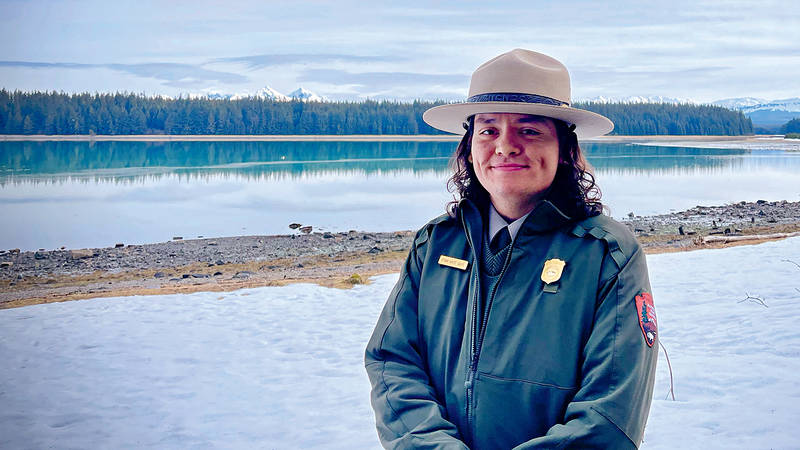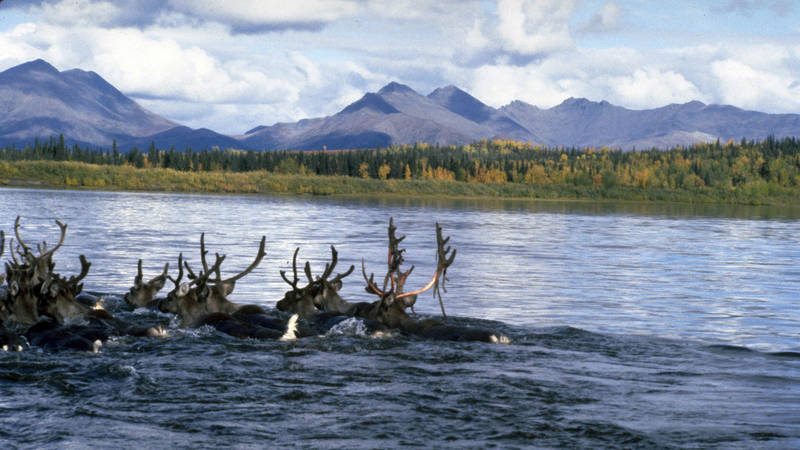Summer 2024
A Building of Trust
Before even opening, a new welcome center at Katahdin Woods and Waters National Monument is changing the relationship between the park and the region’s Wabanaki Nations.
In a 2019 meeting to discuss plans for a new welcome center in Katahdin Woods and Waters National Monument in Maine, an architectural firm hired for the project presented its early designs. After seeing the images, however, members of an advisory board made up of representatives from the Wabanaki Nations in Maine were disappointed. They explained that the designs, which resembled a farmhouse and a silo, failed to acknowledge the region’s Indigenous past — and instead underscored the history of colonization there.
“That was unfortunate,” said Jennifer Neptune, a Penobscot basket maker and curator. “So the next day we had a long discussion about that, and why that form on that mountain was not only not appropriate, but also hurtful.”

The welcome center’s front-door handles feature traditional “double curve” designs representing each of the four Wabanaki Tribes.
COURTESY OF MARTIN PIERCEDuring follow-up talks, Neptune shared a story about Gluskabe, a legendary Penobscot hero, chasing a moose through stretches of what is now the North Maine Woods. The tale, which follows Gluskabe as he bounds across the ancient watershed and leaps over Penobscot Bay, is also a detailed oral map, which has been passed down over generations, Neptune said. “It’s so brilliant, and so much a part of our connection to the rivers and ocean and the whole landscape.”
The architects went back to the drawing board. The Tribal advisory board was expanded to include at least two members from each of the Wabanaki Tribes — Penobscot Nation, Houlton Band of Maliseet Indians, Mi’kmaq Nation and Passamaquoddy Tribe — and the vision for the project began to shift.
In August, the public will get its first peek at the new center, which is the result of a five-year collaborative process that also included designers, builders, partner organizations and the National Park Service. From above, the 7,900-square-foot, mass timber structure is meant to resemble a moose antler, with asymmetrical wings branching out from a central hub.
The building’s name, Tekαkαpimək (pronounced de gah-gah bee-mook), from the Penobscot language, means “as far as one can see.” Perched on Lookout Mountain, the center will offer views of the 5,269-foot Katahdin to the west, and it will also have an outdoor eastern lookout (the Wabanaki are known as People of the Dawn) paved with locally quarried stone. Other features include accessible paths, bird-safe windows and minimal exterior lighting to protect the monument’s status as an international dark-sky sanctuary. The off-grid building will rely on a solar array for electricity and will be passively cooled and heated for the most part.
For us it never was wilderness — it was always home.
Inside, exhibits and pieces of original artwork will give a Wabanaki perspective on the woods, waterways and human presence in the region, which goes back at least 11,000 years. The building’s signage will be in the Penobscot language, with English translations underneath. This focus on an Indigenous point of view is unusual, said Neptune, the building’s lead exhibit writer, in a region where museums tend to put more focus on settler or logging history, or treat the Maine Woods as a big, empty frontier. “For us it never was wilderness — it was always home,” she said.
BEHIND THE SCENES
The welcome center — officially known as a “contact station” — is the first major infrastructure installed in the monument since President Barack Obama used the Antiquities Act to create it in 2016. Friends of Katahdin Woods and Waters has coordinated the $35 million fundraising drive, which is nearing its conclusion. Most of the private donations are being used for the building project, and the remainder will go toward Park Service priorities such as signage in the park and Wabanaki-directed projects that will benefit the Tribes.
Advocates hope the new building will attract more people to this somewhat out-of-the-way, ruggedly wild 87,500-acre site, which is popular with paddlers and seasoned hikers but a tougher sell for those unaccustomed to exploring the backcountry. The monument averages around 40,000 annual visitors; by comparison, nearby Acadia National Park drew nearly 4 million visitors last year. A fresh 3.6-mile access road to the welcome center will help the cause.
“This building is going to bring a level of attention that is really going to change the dynamics of visitation, in my opinion,” said Lucas St. Clair, whose family donated the land for the monument, and who runs Elliotsville Foundation Inc., which is overseeing the center’s plans and construction. When the monument was designated, the family arranged for the deed to allow them to pursue privately funded projects on certain parcels of land, in consultation with the Park Service. Around that time, St. Clair tapped Norway-based, Canadian-born architect Todd Saunders for the contact station project.
When St. Clair first envisioned the station during a hike in 2011, it felt kind of like a fantasy, he said. “But sure enough, here we are, 13 years later, and it’s almost done.”
NPCA AT WORK
The ethos in the founding documents of Katahdin Woods and Waters, which specifically cite the need for “shared stewardship” of resources with the Wabanaki people, has gotten a boost from recent federal policy. In 2021, Deb Haaland, the first Native American Secretary of the Interior, issued a joint order with the Secretary of Agriculture to safeguard the interests of Tribes in managing federal lands, waters and wildlife, which called for (among other requirements) a legal review of treaty obligations. More recently, at the 2023 White House Tribal Nations Summit, Haaland announced new guidelines for the inclusion of Indigenous knowledge in departmental decisions and research.
The contact station project takes such protections further: All Indigenous-created art and interpretive content in the building will remain the property of the Tribes, even after the building is donated to the federal government. This will require creating a database of items in the building, so each individual design or hand-pressed clay tile can be traced to its owner.
“There’s always been this feeling of taking,” Neptune said, “like people don’t protect what we’ve told them or shared with them. So this is a whole different model of working together that does respect Indigenous knowledge and culture. I hope moving forward that NPS does this on future projects as well.”
Gabriel Frey, a Passamaquoddy artist whose family legacy of black-ash basket making can be traced back 13 generations, has worked on several artistic elements for the building. He spent about two months carving wooden molds for the front-door handles, which were then cast in bronze. The handles feature original designs — crafted by each of the four Tribes — representing everything from the rising sun to the ocean, sweetgrass and medicine leaves. “Those designs belong to the entire Wabanaki community,” he said.

We’re Still Here
Every national park site sits on ancestral lands. So what does it mean to be a Native American working for the Park Service today?
See more ›Frey also led the five-person team that created the woven copper ceiling above the information desk, which seems to undulate like the surface of a river. Together, all these building elements convey the message “we’re still here,” Frey said. “Our culture is still here, and it’s still vital and rich. That was something we really wanted to impress upon visitors.”
Shaping a curatorial vision for the building has been an incredible amount of work, Neptune said, and at times she’s felt the stress of managing different voices and interests. But she hopes when the doors open, Tekαkαpimək will offer visitors a glimpse of Wabanaki culture, while giving Native people in Maine a feeling of recognition. Most of all, she said, her wish is that “when Native children go there, they finally get to see their language and their ancestors looking back at them through what is included in that place. I hope they see themselves and that they’re proud.”
About the author
-
 Dorian Fox Contributor
Dorian Fox ContributorDorian Fox is a writer and freelance editor whose essays and articles have appeared in various literary journals and other publications. He lives in Boston and teaches creative writing courses through GrubStreet and Pioneer Valley Writers' Workshop. Find more about his work at dorianfox.com.



